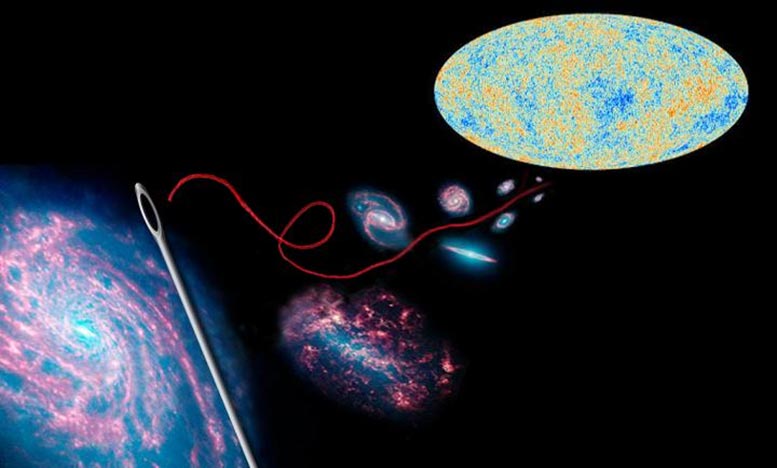
Solving the discordant data on the expansion rate of the universe is like trying to thread a ‘cosmic needle’, where its hole is the H0 value measured today and the thread is brought by the model from the furthest Universe we can observe: the cosmic microwave background. Credit: NASA/JPL-Caltetch/ESA-Planck Collaboration/SIN
Physicists use two types of measurements to calculate the expansion rate of the universe, but their results do not coincide, which may make it necessary to touch up the cosmological model. “It’s like trying to thread a cosmic needle,” explains researcher Licia Verde of the University of Barcelona, co-author of an article on the implications of this problem.
More than a hundred scientists met this summer at the Kavli Institute for Theoretical Physics at the University of California (USA) to try to clarify what is happening with the discordant data on the expansion rate of the universe, an issue that affects the very origin, evolution, and fate of our cosmos. Their conclusions have been published in Nature Astronomy journal.
“The problem lies in the Hubble constant (H0), a parameter which value -it is actually not a constant because it changes with time- indicates how fast the Universe is currently expanding,” points out cosmologist Licia Verde, an ICREA researcher at the Institute of Cosmos Sciences of the University of Barcelona (ICC-UB) and the main author of the article.
The two ways of measuring the Hubble constant do not give the same result.
“There are different ways of measuring this quantity,” she explains, “but they can be divided into two major classes: those relying on the Late Universe (the closest to us in space and time) and those based on the Early Universe, and they do not give exactly the same result.”
A classic example of measurements in the late universe is those provided by the regular pulsations of cepheid stars, which the astronomer Henrietta Swan Leavitt already observed a century ago and which helped Edwin Hubble calculate distances between galaxies and prove in 1929 that the Universe is expanding.
The current analysis of the variable brightness of cepheids with space telescopes such as the Hubble, along with other direct observations of objects in our cosmic environment and more distant supernovae, indicate that the H0 value is approximately 73.9 kilometers (49.3 miles) per second per megaparsec (an astronomical unit equivalent to about 3.26 million light-years).
However, measurements based on the early Universe provide an average H value of 67.4 km/s/Mpc (41.9 m/s/Mpc). These other records, obtained with data from the European Space Agency’s Planck Satellite and other instruments, are obtained indirectly on the basis of the success of the standard cosmological model (Lambda-CDM model), which proposes a Universe made up of 5 % atoms or ordinary matter, 27 % dark matter (made up of particles, as yet detected, that provide additional gravitational attraction so that galaxies can form and clusters of galaxies are held together) and 68 % dark energy, which is responsible for accelerating the expansion of the Universe.
“In particular, these measurements of the primordial Universe focus on the farthest light that can be observed: the cosmic microwave background, produced when the Universe was only 380,000 years old, in the so-called recombination era (where protons recombined with electrons to form atoms),” says Licia Verde.
The researcher highlights a relevant fact: “There are very different and independent ways (with totally different instruments and scientific tools) to measure the H0 on the basis of the early Universe, and the same goes for the late Universe. What is interesting is that all the measurements of one type are in mutual agreement with one another, at an exquisite precision of 1 or 2 %, as are those of the other type, with the same great precision; but when we compare the measurements of one class with those of the other, the discrepancy arises.”
It is like trying to thread a ‘cosmic needle’ where its hole is the H0 value measured today and the thread is brought by the model from the furthest Universe.
“It looks like a small difference, only 7%, but it is significant considering that we are talking about precisions of 1 or 2% in the value of the Hubble constant,” as emphasized by Licia Verde, who jokes: “It is like trying to thread a ‘cosmic needle’ where its hole is the H0 value measured today and the thread is brought by the model from the furthest Universe we can observe: the cosmic microwave background.”
In addition, she points out some of the consequences of the discrepancy: “The lower the H0 is, the older the Universe is. Its current age is calculated at about 13.8 billion years considering that the Hubble constant is 67 or 68 km/s/Mpc; but if its value were 74 km/s/Mpc, our universe would be younger: it would be approximately 12.8 billion years old.”
Modifying the model in the early Universe
The authors point out in their study that this anomaly does not seem to depend on the instrument or method used for measuring, or on human equipment or sources. “If there are no errors in the data or measurements, could it be a problem with the model?” the researcher asks.
“After all, the H0 values of the primordial Universe class are based on the standard cosmological model, which is very well established, very successful, but which we can try to change a little to solve the discrepancy,” says the expert. “However, we cannot tamper with the characteristics of the model that work very well”.
If the data continue to confirm the problem, theoretical physicists seem to agree that the most promising route for solving it is to modify the model just before the light observed of the cosmic microwave background was formed, i.e. just before recombination (in which there was already 63% dark matter, 15% photons, 10% neutrinos, and 12% atoms). One of the ideas proposed is that, shortly after the Big Bang, an intense episode of dark energy could have occurred that expanded the Universe faster than previously calculated.
“Although it is still highly speculative, with this fine-tuned model, the H0 value obtained with measurements based on the primordial Universe could coincide with local measurements,” notes Licia Verde, who concludes: “It won’t be easy, but in this way we could thread the cosmic needle without breaking what works well in the model.”
Reference: “Tensions between the early and late Universe” by Licia Verde, Tommaso Treu & Adam G. Riess, 27 September 2019, Nature Astronomy.
DOI: 10.1038/s41550-019-0902-0

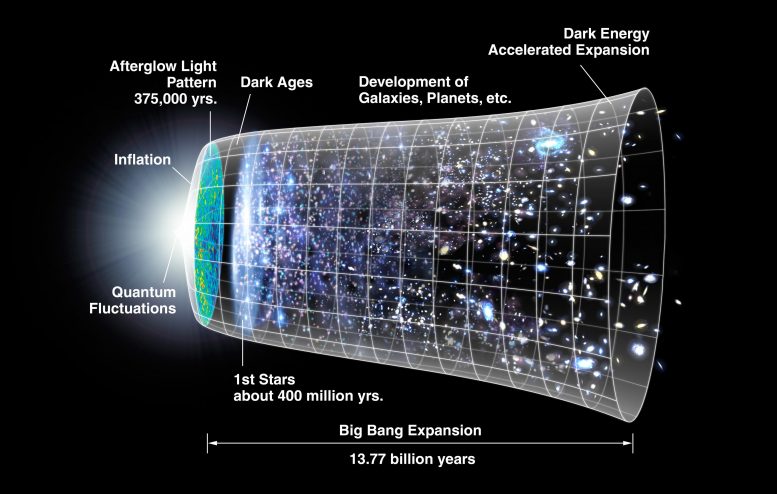
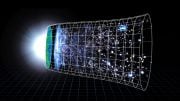
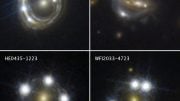
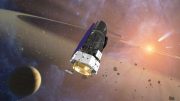
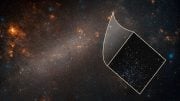
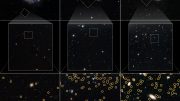
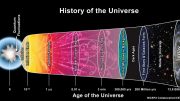
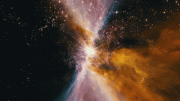
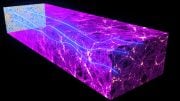
This is typically when someone smart figures out it’s not a constant, and starts trying to map the variations to see if they line up with other things like say, the background radiation pattern.
starts trying to map the variations to see if they line up perfectly.
That’s great indeed.
Expansion and contraction of the parts of the universe are determined by the property of Chiral-supersymmetey-dipolar electro- magnetic condensates. The size of the condensates is unlimited, and mostly called blackholes(non classical) that create dipolar jets, that may go for millions of light years.
So the hubble constant cannot be correct.
Expansion and contraction are occuring in various parts of the universe.
To explain one needs to understand the properties of Chiral Super Symmetry dipolar electromagnetic condensates and transients from Axion matter to Neutron matter.
There’s no constant for that, and I think I have the answer.